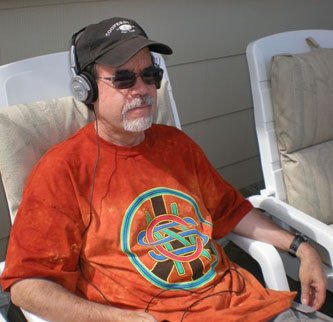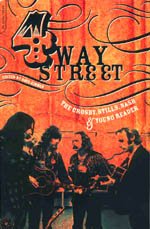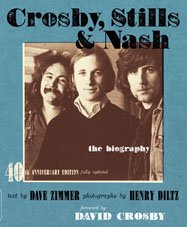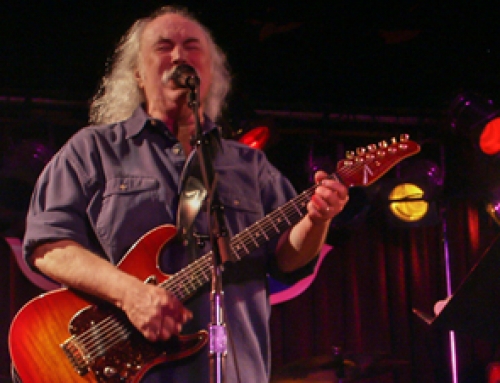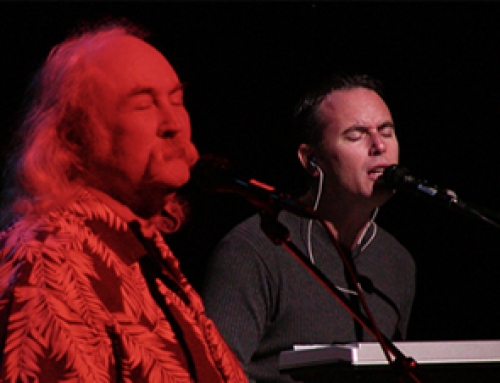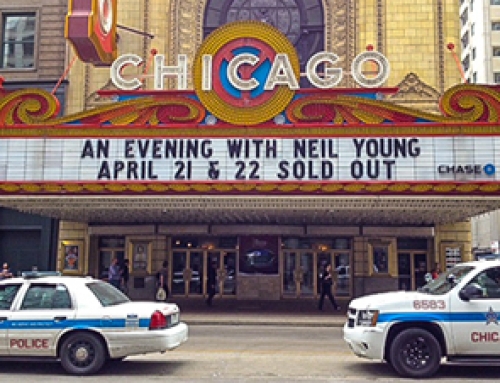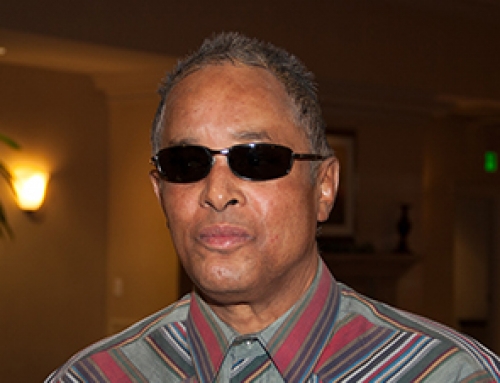By: Dave Zimmer – 4WaySite Exclusive
Date: 15 August, 2009
Dave Zimmer’s Unedited, Previously Unpublished Interviews About CSN&Y with Writers Peter Doggett, John Einarson, Johnny Rogan and Steve Silberman.
Dave Zimmer: “With the 40th anniversary of Woodstock at hand, the time feels right to share several short interviews about Crosby, Stills, Nash & Young I did by e-mail with writer colleagues/ friends Peter Doggett, John Einarson, Johnny Rogan and Steve Silberman back in late 2007 and early 2008. Some of their comments were potentially going to be included in the update chapter for the latest edition of Crosby, Stills & Nash: The Biography. During the final editing process, however, it was decided by my Da Capo Press editor that the writers’ views and insights, while by turns informative and fascinating, interrupted the flow of the narrative text. As a result, with the exception of an excerpt from a Johnny Rogan comment, their words were left on the editing room floor.
Thanks to 4WaySite web site manager Dolf van Stijgeren, the question and answer interviews are presented here, in unedited form. So put on your favorite CSN&Y music, settle back and read on”.
PETER DOGGETT
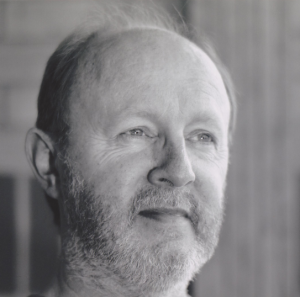 Peter Doggett is one of the UK’s leading rock writers and journalists. He was editor of Record Collector magazine for fifteen years, and currently writes for Mojo and Q, among other publications. His most recent book is There’s A Riot Going On: Revolutionaries, Rock Stars, and the Rise and Fall of the ’60s. He is also the author of Are You Ready for the Country? In addition, he has also written biographies of John Lennon and Lou Reed.
Peter Doggett is one of the UK’s leading rock writers and journalists. He was editor of Record Collector magazine for fifteen years, and currently writes for Mojo and Q, among other publications. His most recent book is There’s A Riot Going On: Revolutionaries, Rock Stars, and the Rise and Fall of the ’60s. He is also the author of Are You Ready for the Country? In addition, he has also written biographies of John Lennon and Lou Reed.
Dave Zimmer: What is it about CSN and CSNY that keeps the musicians themselves coming back to the combinations — even now that all of the guys are in their 60s?
Peter Doggett: At its most basic, the reason is money: would Stills and Crosby work together unless it was so financially lucrative that they felt they had to? I doubt it very much. It’s obvious that Stills prefers to work alone; likewise Crosby & Nash as a duo; but it’s the trio, and especially the quartet, that pulls in the crowds. (Sadly none of these combinations can sell records any longer, no matter how good they are.) Plus one could get into a long psychological debate about the way in which Young has treated CSN down the years, using and losing them as it suits him, and manipulating CSNY like a dictatorial control freak.
But I’d rather accentuate the musical side of these equations. While CSN has, for the past two decades, effectively been a (wonderful) oldies act, CSNY pushes all four musicians into places they couldn’t reach any other way. That was brought home to me when I finally got to see all four perform together in 2002: Stills and Young fired each other up like demon engines, and Crosby and Nash picked up on that vital energy. For three remarkable hours, four flawed individuals became an almost supernatural positive force. During those moments, money is no longer the motivation – although they wouldn’t have allowed themselves to get into that position unless they were getting paid.
DZ: What keeps their audiences coming back?
PD: As with every ‘classic’ act, most of the audience for CSNY is there for nostalgia – a reminder of when they felt young and vital, with the power to change the world. Nobody imagined in 2006 that CSNY could help to overthrow Bush, the way that their audience must have felt with Nixon in 1970 (not to mention 1974). But it must have been wonderful to relive the sense of possibility.
Beyond the baby boomers who would just as soon go and see Chicago or the Doobie Brothers, people like us go back to see all the CSNY combinations because we’re still moved by the songs, dazzled by the harmonies, and electrified by the passion. Part of that is nostalgia; a larger part is that when, for instance, C&N are performing Guinnevere, there’s nowhere else in the world we’d rather be.
DZ: How much has the drama of their lives and the guys’ personal turmoil contributed to the allure and popularity of CSN and CSNY?
PD: You could reverse the question, and ask how much their popularity has been harmed by the drama and turmoil. How big and influential a band might CSNY have been if they had maintained their unity from 1970 through to the end of the decade? How much great music was wasted on the way? Yet as a committed fan, the intrigue, the endless arguments, the shifting of allegiances, the life-and-death struggles, and the triumphant return of C, S and N as recording artists in the past decade, has been like wallowing in a glorious soap opera. If the guys’ egos hadn’t been so big that they were bound to collide, endlessly, then they wouldn’t have been the personalities and musicians that they are.
DZ: How do you think the CSN/CSNY story will ultimately end? And what will their epitaph be?
PD: There won’t be any end beyond the end that awaits us all. While they’re still alive, they’ll still be making music. Epitaph? It will be in the words of the songs: Teach Your Children, Love The One You’re With, “remember what we’ve said and done and felt about each other”. Historically, they’ll be remembered as the epitome of the Woodstock generation, whether they like it or not. But I’d rather they were remembered for producing music that was both breathtakingly beautiful and fiercely powerful.
DZ: What is it about Crosby, Stills, Nash and Young, collectively and individually, that first attracted you and why do the guys and their music continue to hold your interest and enthusiasm?
PD: Stills was my main man, originally, and then Young, and it took me a while to realise that I loved all four (and maybe Crosby most of all). I’ve always been a sucker for harmonies, and CSN’s harmonies are like nobody else’s. But there’s so much more than that. I love Crosby’s weirdness and Nash’s directness and Stills’ soulfulness and Young’s inspiration. For all their faults, I love the four individuals who created and inhabit their songs. Their music lives in my head, day after day, and if you catch me singing on a street corner, it will almost always be a CSNY-related song. How can you deliver a rational explanation for falling in love?
DZ: What is your most memorable personal moment (or moments) with individuals in the CSNY family?
PD: Having been fortunate enough to interview CS&N on several occasions, there have been a few . . . sitting round a table in London with CSN, realising that for the next hour, I was the fourth member of the quartet . . . getting a chance to experience the original personal chemistry that united the trio, as they playfully batted jokes back and forth and teased each other mercilessly . . . the evening when my phone rang, and a voice said, “Hi Peter, this is David Crosby”, followed a few minutes later by another call, and “Hi Peter, this is Graham Nash” (I tried to imagine how the 15-year-old me would have felt) . . . Crosby interrupting a passionate rant about CPR to compliment me on my socks . . . Stills and I bellowing at each other for 90 minutes in a London hotel room, trying to overcome our mutual inability to work out what the hell the other one was saying . . . Crosby’s boyish enthusiasm whenever he gets a compliment . . . Nash’s sardonic humour . . . and then there are the musical memories: the Suite at Wembley in 1983, greeted by the longest ovation I’ve ever heard from any crowd; CSN opening up with Deja Vu a lifetime later at another London show; likewise Crosby and CPR in a small London club, opening with Music Is Love; Young and Crazy Horse in full ecstatic flight; and every time I’ve heard Crosby and Nash winding their voices around Guinnevere. Not to mention the next time I play any of their records.
JOHN EINARSON
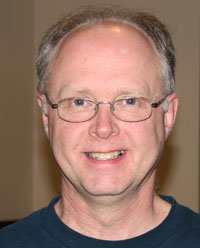 Renowned rock historian John Einarson is the author of more than a dozen books, including the critically-acclaimed Hot Burritos: The True Story of the Flying Burrito Bros., voted among the 10 Best Books of 2008 by Uncut; Mr. Tambourine Man: The Life and Legacy of The Byrds’ Gene Clark, voted among the 20 Best Books of 2005 by Uncut and Record Collector; For What It’s Worth: The Story of Buffalo Springfield; Don’t Be Denied: Neil Young’s Canadian Years, and Randy Bachman: Takin’ Care of Business, among others.
Renowned rock historian John Einarson is the author of more than a dozen books, including the critically-acclaimed Hot Burritos: The True Story of the Flying Burrito Bros., voted among the 10 Best Books of 2008 by Uncut; Mr. Tambourine Man: The Life and Legacy of The Byrds’ Gene Clark, voted among the 20 Best Books of 2005 by Uncut and Record Collector; For What It’s Worth: The Story of Buffalo Springfield; Don’t Be Denied: Neil Young’s Canadian Years, and Randy Bachman: Takin’ Care of Business, among others.
Dave Zimmer: What is it about CSN and CSNY that keeps the musicians themselves coming back to the combinations — even now that all of the guys are in their 60s?
John Einarson: It’s a case of the sum of its parts being greater than the individuals. When the members of CSN or CSNY come together what they create is something wholly unique and special that they do not experience individually or in other combinations. It’s a ‘1+1+1 = 4’ thing, something distinctive and extraordinary that each member brings to the collective that is only present in that combination and transcends their individual musical personalities. There was a joy that the three experienced when their voices first blended together. There was nothing like it anywhere else then and nothing since. Together they create a certain magic absent on their own. And they recognize that. Despite all the water under the bridge over the years, when those three or four voices come together in song it’s a sound like nothing else. That’s a pretty compelling attraction for them.
DZ: What keeps their audiences coming back?
JE: CSN and CSNY are a touchstone to a particular time and place for millions of people. They are the living embodiment of the Woodstock generation and their music and message continue to resonate with a particular age group, that same peace and love sentiment that we all still idealize and aspire to. It wasn’t just fluffy pipe dreams. It was real, and CSN(Y) reminds us of an idyllic time in our lives and in the world when we all believed music could, indeed, change the world. They and their music have become icons of an era, symbols for a generation. And because their music has substance and a universally-appealing message that spans the generations they continue to draw new and younger fans to their concerts.
DZ: How much has the drama of their lives and the guys’ personal turmoil contributed to the allure and popularity of CSN and CSNY?
JE: I don’t think the wider world is really aware of all the drama and internecine warfare over the decades between the individuals in the group. Certainly David Crosby’s life has provided plenty of tabloid fodder and perhaps that has some attraction for fans. But I believe it’s still all about the music they create together that draws people to the group. That transcends any human drama surrounding the individuals. People don’t always get along, that’s a fact of life and we all accept that, but when these three or four individuals come together that’s a very special moment.
DZ: How do you think the CSN and CSNY story will ultimately end?
JE: The fact that both CSN and CSNY have continued to tour and delight audiences is very reassuring. They’re all in their sixties now yet still able to create their own unique brand of magic onstage together night after night. Certainly Nash and Young are capable of surviving the tour grind for several more years but health issues are beginning to plague Stills and Crosby. Realistically I think we’re nearing the end of the line. Better to leave the stage on a high and part as friends than beat something into the ground. They have absolutely nothing they need to prove to anyone. Their legacy remains firmly intact and will outlive them and us. A century from now people will still be singing “Teach Your Children”, “Find The Cost Of Freedom” or “Woodstock”. That music and those sentiments are timeless.
JOHNNY ROGAN
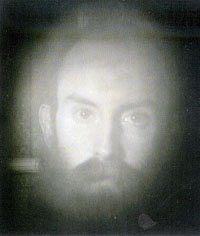 Johnny Rogan is the author of over 20 acclaimed books, including The Byrds: Timeless Flight Revisited, Neil Young: Zero To Sixty and Crosby, Stills, Nash & Young: The Visual Documentary. His other titles include major biographies of Van Morrison, the Kinks, the Smiths, and musical studies of John Lennon and Morrissey, plus the groundbreaking study of rock management, Starmakers & Svengalis.
Johnny Rogan is the author of over 20 acclaimed books, including The Byrds: Timeless Flight Revisited, Neil Young: Zero To Sixty and Crosby, Stills, Nash & Young: The Visual Documentary. His other titles include major biographies of Van Morrison, the Kinks, the Smiths, and musical studies of John Lennon and Morrissey, plus the groundbreaking study of rock management, Starmakers & Svengalis.
Dave Zimmer: What is it about CSN and CSNY that keeps the musicians themselves coming back to the combinations — even now that all of the guys are in their 60s?
Johnny Rogan: There have probably been different reasons at different times. In the past, personal, financial and musical motives have each played a part in the collective decision somewhere along the line. But the noblest reason harks back to the formation of the original trio when they made that pact about not being a group but an aggregation of friends, equally capable of flying solo or in formation. Few believed them at the time, but they proved true to their word. They probably lost millions by declining to ‘reform’ on many occasions over the decades. The skeptics always forget that, don’t they? The foursome have enjoyed playing solo and in different permutations and I’ve loved them all. I think they understood the importance – musically and mythically – of CSN&Y, more than ever on the last couple of tours. Taking an overview, it’s amazing that all four didn’t reconnect more over the years and that was our loss too. It speaks volumes that they never ‘manufactured’ a reunion. You have to admire them for that.
DZ: What keeps their audiences coming back?
JR: Nostalgia? For some, surely. The love of great music, certainly. All their tours have been well received, and rightly so. They’ve often shown an uncanny ability to capture their time, even when that time seemed past. After 1971, we wondered whether the magic foursome would ever reconvene, and there was a ludicrous 28 year gap between album releases. But in 1974 we had the stadium tour. The counter culture seemed in decline then, their own lives affected by related tales of doom and death – read the books! I described them as ‘lost King Arthurs in search of a Camelot’. But that summer, they reclaimed all that had seemed lost. The spectre of Sixties idealism returned with them – their arch nemesis Richard Nixon was impeached, as if fulfulling the prophecies of Young’s ‘Ohio’ and Stills’ ‘America’s Children’, Muhammad Ali reclaimed the world heavyweight championship and there was CSN&Y defining the age once more. Nor was this simply nostalgia for Woodstock survivors. The foursome were still introducing new songs of high quality…. Flash forward to more recent times, a different age, a different president, a different war, but CSN&Y had once again found a cause. There was nothing cosily nostalgic about this tour. They had something to say and captured their time yet again. Listen to the tapes, watch the DVD. It’s like ancient warriors returning to remind the world of lost ideals, seeking to inspire again. It would have been even better if they took the last tour around the world, as they have a global audience and this was about more than the fight for the political heart and soul of America. . . Beyond all that, CSN&Y offer their audience a unique sense of history. How many other aggregations from the late Sixties can still boast an original line-up intact? Given their colourful histories, they’ve done remarkably well to escape the blade of the Grim Reaper. Consider Crosby’s lengthy spell in freebase hell and even recent heart trouble; Nash’s boating accident which might easily have cost him his life; Young’s brain aneurism; Stills’ health problems. As a result, there’s a feeling of event when CSN&Y tour or record – always the unspoken thought that this could prove the last time around. Near death scares ensure audiences treasure the moment even more.
DZ: How much has the drama of their lives and the guys’ personal turmoil contributed to the allure and popularity of CSN and CSNY?
JR: I’m sure it’s all contributed to the myth, but for me it was their music that was most important. There was little known about the turmoils in Buffalo Springfield or even the Byrds when that wonderful debut album ‘Crosby, Stills & Nash’ was released. What people responded to was the power and quality of the music. They were the masters of acoustic music at the dawn of the golden age of the singer songwriter. This was before Woodstock, before superstardom, before Neil Young even joined. Later, we learned of their romantic lives, their politics, their drug use, their internal conflicts, their cultural importance – and much else. Obviously this added appeal and column inches but that would have meant nothing without the music. Looking back now, I’m still amazed at that scarcely believable run of releases – ‘Crosby, Stills & Nash’, ‘Deja Vu’, ‘Stephen Stills’, ‘After The Goldrush’, ‘If I Could Only Remember My Name’, ‘Songs For Beginners’, onward to Manassas … the songwriting quality and self belief is staggering. It’s as if they knew that between them they could single-handedly create the finest music of the early Seventies. Every time one of them issued an album, it was an event.
DZ: How do you think the CSN/CSNY story will ultimately end? And what will their epitaph be?
JR: Well, it will end in death, of course, as all things do. Their epitaph? Probably some cliché about being spokespersons for the Woodstock generation or rock’s premier supergroup, but that’s lazy shorthand for a more complex legacy. I trust history will acknowledge their importance and immense contribution to popular music.
DZ: What is it about Crosby, Stills, Nash and Young, collectively and individually, that first attracted you and why do the guys and their music continue to hold your interest and enthusiasm?
JR: Well, obviously, as a massive Byrds fan I was eager to hear what Crosby would do next. I liked the Hollies too and had even seen Graham Nash’s final appearance with them in a star-studded cast at the Save Rave on 8 December 1968. I also had a Buffalo Springfield album and given I was still a school kid these were not casual purchases. The single ‘Marrakesh Express’ was the first taster but nothing prepared me for the moment I placed the needle on the record and heard that opening album track, ‘Suite: Judy Blue Eyes’. It’s difficult to express how refreshing and astounding it was to hear those exquisite three-part harmonies, the beautiful melodies and thoughtful, poetic lyrics. It seemed that they were taking the mantle from the Beatles as singer songwriters supreme.
Already masters of the acoustic ballad, they also revealed themselves as a great rocking electric ensemble, as shown through concert performances and the succeeding ‘Deja Vu’. I’ve already mentioned the solo outings and recall endless debates – often simply in my own head – about whether Stills’ debut album was even better than ‘Deja Vu’ or Crosby’s first solo better still. It really was that important – and those records were amazing. Obviously, I was always in there for the long haul and that was important too. Loyalty can bring its own rewards. Many listeners left the party prematurely after the initial hurrah. Some may not even have bought the great ‘On The Beach’ or missed Stills’ wonderful 1975 album. The 1977 ‘CSN’ record was another strong effort, underrated in the UK in that summer of punk. The Eighties was a dark decade for the foursome. They were dismissed by post punk critics as beyond passé; even Neil Young was criticizing the other three in print and in song. Record releases were infrequent and… well you know the story. But musical trends are often cyclical and their legacy was too great to be ignored, especially when acoustic music came back into vogue. Now their standing seems beyond assured, but for those who followed them from the late Sixties till today, there were many dark nights of the soul. In those pre-Internet days, it sometimes seemed that there were only a small number of people who still carried a torch for them. At least that was the experience on this side of the Atlantic. I always stood up for them, as well I might given what they had achieved.
One of the few times I wrote to the music press was after Mojo did a major retrospective piece on them which I thought was unfairly balanced. It’s pleasing to see that, at the time of writing, they’re still alive and seemingly well. CPR is a great project, Stills and Nash are delving into their archives and hopefully will be sufficiently inspired to issue some new work; Young continues indefatigably and still has the capacity to surprise. It’s a wonderful story with a happier ending than anybody could have anticipated.
DZ: What do the four mean to you? Why did you spend so much time and energy covering them? What impact did they have on your life?
JR: Wow. CSN&Y were the enshrinement of a dream. As individual songwriters, they were thrilling but together they had the power to become even greater than the sum of their parts. Beyond the music there was the added attraction of a romantic philosophy of which they may not even have been aware. It was as if they advocated a mantra of free love but by placing it in such a powerful personal context they exchanged any licentiousness for what seemed like an aspect of neo-Romanticism, more reminiscent of the courtly love precepts of Chaucer. Their impact on my life was profound. The reason I spent so many years covering their careers was the same reason why I still play their records today – an intense engagement with the music, writing and personalities. It’s like a life-long commitment. Writing the CSN&Y book was a tremendous joy as I was able to choose the photos, contribute all my concert tickets and the like and throw in the kind of arcane stuff that I felt would complement the more formal bio. I think the contract said up to 50,000 words, but I did 110,000 and got them to swallow the extra cost. Hey, this was CSN&Y – one of the great loves of my life!
DZ: What is your all-time favorite personal moment (or moments) with individuals in the CSNY family?
JR: Time to get personal . Undoubtedly, my favourite moment as an interviewer with anyone ever was my first serious encounter with David Crosby over two long days during his five-night stint at London’s Venue in April 1980. It was the greatest interview of my life. Crosby was passionate, brutally honest, funny, angry – a veritable emotional barometer. Nearly a decade later, the newly rehabilitated Crosby was still charming and flattering and wrote me the cherished epigram, ‘Your knowledge is amazing!’ At a subsequent reception, however, we became unexpectedly embroiled in a heated debate about a song I had recently acquired on tape, ‘Psychodrama City’. Crosby denied he’d composed or even sung this composition, though it was clearly his lead vocal, as I insisted. It was probably a lapse of memory – hardly surprising as this was a minor outtake and Crosby hadn’t really recalled much about ‘It Happens Each Day’ either. But he was resolute, and there were other people around which reinforced his resilience. I adopted the theatrical role of a hardened inquisitor, which he’d previously enjoyed but these were different times and, on reflection, he probably misinterpreted my playfulness as blind arrogance, or worse. Still later, after the song appeared, I wrote him a jaunty teasing note via Bill Siddons, which no doubt made things worse. At the same time, I was grabbling with the Byrds’ name game saga and the role of Gene Clark and Michael Clarke in the scheme of things. Contentious stuff. I’m sure that didn’t help. Some years later, Crosby suddenly and severely castigated me in the fiercest possible terms – albeit online as opposed to print. He’s the only person in the music business whose words have ever caused me hurt or upset – and the least expected considering his previous flattering comments. There’s a moral there, I suppose. His former mentor Jim Dickson, actually wrote me a letter afterwards empathizing!
There are countless wonderful concert memories involving all four members from different eras. Surprisingly, perhaps, I’d nominate the Crosby/Nash shows from 1971 as the most emotionally powerful, brimming with humour, empathy and a thrilling acoustic reinterpretation of their finest work. Equally importantly, I was still a teenager and at that age you’re arguably at your most receptive and impressionable. Manassas was spectacular too and thank goodness they came to the UK or I’d never have seen them. By contrast to the intimacy of Crosby/Nash, the 1974 CSN&Y Wembley extravaganza was the ultimate day out – the Band, Joni, and three and a half hours of CSN&Y at their zenith. There were many others, of course, but the early ones tend to stick in your mind as it was all so new and exciting. It felt like history in the making.
Favourite slice of humble pie was witnessing Stills at Central Park in July 1979 and feeling sorely disappointed. It was a strange period at the end of the Seventies. The record industry was changing and singer songwriters were under threat. They all needed to be at the top of their game then, but it was a period of uncertainly. It’s always difficult for a performer to sustain greatness and evolve at the same time. That was such a strange show. Brooks Hunnicutt was doing ‘Love The One You’re With’. I think I misjudged what Stills was trying to do. Sixteen years later I dutifully and rather apprehensively listened to a tape of that Stills’ show while researching my CSN&Y book and was amazed how audacious, adventurous and even subversive it sounded. This was Stills’ ‘Tonight’s The Night’ – the ultimate deconstruction of his rock star myth. Riveting. I wrote about it at length in the book. They should release that stuff too. It deserves a re-evaluation. . . .A final word on Stills. Years ago, we used to regard Young as the dark, brooding, mystery figure and Stills as the open, media-friendly spokesman and personality. Since then, Young has revealed intimate details about his life and work, via ‘Shakey’. Crosby, whose interviews were once gold dust re-emerged as a ubiquitous interviewee and has since produced two autobiographies, written with Carl Gottlieb. Tellingly, Stills appears in none of these tomes, even though his role was central. It’s funny but, in terms of information, he now seems to have taken on the mantle of mystery once allocated exclusively to Young. Who’d have thought it? It may sound fanciful but I’ve often wondered whether there was some existential moment in the late Seventies when everything changed utterly for Stephen Stills. I remember Crosby telling me – and he said something similar in the Zimmer book – how Stills back in 1974 wanted CSN&Y to be bigger than the Stones. That unrelenting ambition had been evident in his career since the Buffalo Springfield days through Manassas, a creative whirlwind, punctuated by a series of catalogue busting songs. We all thought he’d match Young release for release thereafter. People can talk about ego, drugs or hubris, but there’s something deeper about Stills’ seeming abnegation of rock godhead. In more recent years you can detect an emotional detachment and slightly comic incredulity in his asides as if he is aware of the vanities of ‘stardom’ and can no longer connect with that brash young man of the early Seventies. And that, I would argue, has paradoxically enhanced his legend as much as it has diminished his output. Derek Taylor once reminded me that the Beatles and the Byrds deserve endless analysis – the same applies to CSN&Y.
DZ: What buried CSN/CSNY archival treasure that you are aware of would you like to see/hear officially released?
JR: This may come as a surprise but I find myself strangely satiated these days. What with the recent box sets and higher quality of unreleased CD-R recordings we’re well provided for. I still get a shiver when a demos CD comes out though. I welcome more of those. Plus, I keep returning to the originals, which is a testament to their longevity. There are a number of Stills’ unreleased songs that I’ve never heard dating back to the mid to late Seventies, but I’m half-scared that they might prove anti-climactic. I wish there was more of Crosby from the early Byrds period or before then. Some stuff seems to have disappeared forever. But I’d still love to hear more before I shuffle off this mortal coil. Beyond that, I am content.
STEVE SILBERMAN
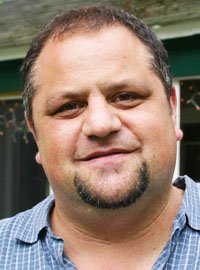 Steve Silberman is a contributing editor at Wired magazine and author of liner notes for several Crosby & Nash album re-issues, including Wind on the Water, Whistling Down the Wireand Crosby-Nash Live. He also wrote essays for C&N’s Another Stoney Evening, David Crosby’s Voyage box set and Crosby, Stills & Nash’s Greatest Hits. He co-authored, with David Shenk, the book, Skeleton Key: A Dictionary for Deadheads. His essays on the Grateful Dead appeared in the book, The Grateful Dead Reader, as well as other books and magazines. Steve has also written liner notes for several Grateful Dead album re-issues and co-produced a five-CD Grateful Dead box set of unreleased recordings, So Many Roads (1965 – 1995). He is also co-host of several conferences on The Well, one of the most perspicacious and longest-lasting online communities.
Steve Silberman is a contributing editor at Wired magazine and author of liner notes for several Crosby & Nash album re-issues, including Wind on the Water, Whistling Down the Wireand Crosby-Nash Live. He also wrote essays for C&N’s Another Stoney Evening, David Crosby’s Voyage box set and Crosby, Stills & Nash’s Greatest Hits. He co-authored, with David Shenk, the book, Skeleton Key: A Dictionary for Deadheads. His essays on the Grateful Dead appeared in the book, The Grateful Dead Reader, as well as other books and magazines. Steve has also written liner notes for several Grateful Dead album re-issues and co-produced a five-CD Grateful Dead box set of unreleased recordings, So Many Roads (1965 – 1995). He is also co-host of several conferences on The Well, one of the most perspicacious and longest-lasting online communities.
Dave Zimmer: What is it about Crosby, Stills, Nash and Young, collectively and individually, that first attracted you? Why do the guys and their music continue to hold your interest, inspire you and spark feelings that make you think and fill you with wonder?
Steve Silberman: I was 12 years old when I walked into a sandal shop in Provincetown and heard the most beautiful and mysterious music I’d ever heard in my life. When I asked the guy behind the counter what was playing, he uttered a series of names that sounded more like a law firm than a rock group. Cool music, I thought, but a dorky name for a band. The song I heard that day was “Guinnevere.” Listening to the song today after hearing it hundreds of times since in various live and studio versions, it still strikes me as one of the most evocative and elusive pieces of music ever written. The melody and lyric seem to create their own place and time in an endless spiral, where King Arthur and peripatetic sailors and maidens who sneak into gardens at night to inscribe mystic symbols on a wall coexist in a kind of twilit landscape, like the mind at the edge of sleep. And those harmonies!
A few months later, when I walked into a department store to buy my first record album, I chose Déjà Vu. The photo on the cover also seemed to exist outside of time, in a mythical California that was still the Wild West. The range of music on that record was astonishing – from Stephen’s muted, almost private reckoning with his past in “4+20,” to the incandescent passion of the guitars in “Almost Cut My Hair” and “Everybody I Love You,” to Neil’s sweeping “Country Girl” epic. Almost every other band (with the notable exception of the Beatles) seemed to make music in a much smaller universe. CSNY instantly became the music of my soul, a gateway to the subtleties of my own feelings, a light into the secret places of the heart. As I got older, I came to appreciate the dimensions of their art, from Stephen’s microtonal levels of articulation to Neil’s cathartic firestorms. But it was David and Graham’s music that spoke to me in my own inner language. They were obviously best friends who loved each other – you could see it in the wonderful cover shot of Wind on the Water, how profoundly at ease and joyful they were in each other’s presence. And you could see it onstage when they were together. I related to that.
And eventually, I started hearing pieces of what I loved about CSNY music in other music – in Bill Evans’ sublime piano playing, the meditative reveries of Miles Davis, the uncanny sacred polyphonies of Gregorian chant and Perotin’s “Viderunt omnes.” CSNY prepared my ears to hear all that beauty, because their own music was nourished by so many streams of melody and human feeling.
DZ: What is it about David Crosby that makes him such a great friend, online communicator and fellow traveler in this universe?
SS: David thrives in dialogue and relationship – whether he’s immersed in the love of his family, furthering his ongoing 40-year musical conversation with Graham, or dropping into an online forum where the topic at hand is his favorite subject: him. I’m almost glad I didn’t know David before the dark times in the ‘80s, because the David I came to know had been humbled by his very public fall. I only occasionally glimpsed the infamous oversized ego, and more often saw a secretly shy, quirkily brilliant, culturally omnivorous, and restlessly passionate man who loves honesty, social justice, well-wrought tools (sailboat, planes, guitars), and deliciously weird opportunities for creative expression. For all the hysterical media attention David’s gotten over the years – fawning at first, then vicious, and almost all of it clueless about the depth of his recorded legacy – I think he’s actually one of the least-understood figures in popular music. Just as “If I Could Only Remember My Name” was dismissed by the hack critics of its day as a paragon of flaky hippie excess – and is now widely recognized as some of the most idiosyncratically gorgeous and subtle music of the modern era – I have faith that the music David made with CPR will be recognized by future generations for the hard-won wisdom contained in the lyrics and the luminous celebration of mortal life contained in the melodies. When David and his muses commune, he has access to a profound wellspring of the kind of art that teaches you how to live, how to embrace all the ambiguity and suffering and intensity of being human with an open heart. That’s rare in any medium.
DZ: Much has been made, over the years, of the periodic personal differences of opinions and distances between the guys. Why do you think this is? And how has it impacted the music?
SS: While David was forced to face his own oversized appetites in a harsh media glare, Stephen never did. I think that the blunting of Stephen’s magnificent gift by name-your-poison is one of the quiet tragedies of rock and roll. When Stephen recorded the first Crosby, Stills, and Nash album, there was nobody better. As a young man, he could sing with the unearthly purity of an angel, the very earthy and lusty passions of a broken-hearted lover, or the ragged road-weariness of a blues sage. But as Stephen got older, he seemed to lean more and more on the musical bombast that makes people stand up and cheer in arenas, rather than the vulnerable intimacy and quiet fire of his best recordings. David and Graham, however, never lost their sense of how important that intimacy is, because it’s what builds a healing bridge between the inner life of the performer and the inner life of the audience.
DZ: So what is at the heart what makes CSN and CSNY music endure?
SS: At the heart of the magic of CSNY is an alchemical whole greater than the sum of its parts. Like the Beatles, CSNY is an agglomeration of widely disparate personalities and talents that corrects for the shortcomings of the individual players, though they’re all capable of making highly compelling music on their own. David is a musical poet
whose dreamy melodies benefit from having a brilliant lead guitarist articulate them, whether it’s Stephen or Jerry Garcia. Stephen is an astonishingly inventive and soulful player and orchestrator in the studio, but his voice sounds best with the others, and Neil’s presence dares him to greatness. Graham creates simple human stories and writes instantly memorable pop melodies, but his music lacks an edge that Stephen and Neil provide – and David and Graham’s harmonies together are one of the sublime wonders of the audible world. Neil doesn’t need anyone else to make great records, but his tunes never sounded better than with the full force of the “mothership” chorus behind him.
BONUS CROSBY, STILLS & NASH THE BIOGRAPHY “INTERVIEW OUTTAKES”
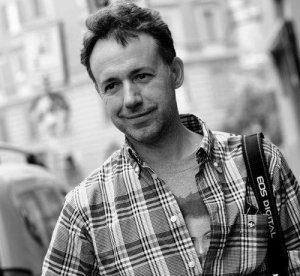 In early 2008, Dave Zimmer also solicited comments from Francesco Lucarelli, CSN&Y archivist, musician (his new album, Love in Dangerous Times, featuring James Raymond, Jeff Pevar, Kenny Passarelli and others, is coming out in the fall) and co-author, with Herman Verbeke, Luciën van Diggelen, and Stefano Frollano, of the three volume book, Crosby, Stills, Nash (and Sometimes Young), for possible use in the Crosby, Stills & Nash: The Biography update chapter. Here is the exchange of questions and answers, presented for the first time.
In early 2008, Dave Zimmer also solicited comments from Francesco Lucarelli, CSN&Y archivist, musician (his new album, Love in Dangerous Times, featuring James Raymond, Jeff Pevar, Kenny Passarelli and others, is coming out in the fall) and co-author, with Herman Verbeke, Luciën van Diggelen, and Stefano Frollano, of the three volume book, Crosby, Stills, Nash (and Sometimes Young), for possible use in the Crosby, Stills & Nash: The Biography update chapter. Here is the exchange of questions and answers, presented for the first time.
Dave Zimmer: What is it about Crosby, Stills, Nash and Young, collectively and individually, that first attracted you and why do the guys and their music continue to hold your interest and enthusiasm?
Francesco Lucarelli: I began listening to them in 1976, when I was just 13. Four Way Street blew me away because of the two different sides of their music: the acoustic ballads and the scorching electric numbers. Plus – obviously – their different voices and the harmonies. I was already listening to the Beatles but it was because of CSNY I began to love all the bands with multiple singers: The Band, Eagles, Buffalo Springfield, The Byrds, Fleetwood Mac.
All these aspects have been sticking on me since then and this is why I love to alternate the raw energy of the rocking numbers and the delicate sound of acoustic guitars whenever I have a gig, possibly having more singers with me on stage, as it happens when I perform with the California Stars ‘n Bars Revue. It doesn’t have to be me in the spotlight, but the beautiful sound coming from all our voices mixed together.
DZ: What is your all-time favorite CSN or CSNY personal moment?
FL: I had the privilege of meeting the guys on several occasions and in different places: from Nash’s hotel room in Manhattan, back in August 1988, when me and Lorenzo Conci helped him to remember the chords and lyrics of Paul Simon’s “America” (which he eventually sang that night during CSN concert at the Meadowlands Arena), to a jam-session and dinner at my place in Roma with David, to an unforgettable three minutes of glory, when David and Graham invited me, Stefano Frollano and Max Rossetti on the stage of Tendastrisce in Roma (April 1992) to sing “Teach Your Children” with them (I shared the mike with Stephen, who I share the same birth date with…only I’m younger! ![]() )
)
Among the many stories, the fondest one is the least musical one of the bunch.
In August 1988, me, Lorenzo Conci and Mauro Coscia were on the East Coast. We flew there to attend 6 CSN shows in a row. We had the chance to arrange a meeting with the Croz in Philadelphia and that morning we were late on our schedule, so we began speeding on the highway. After a few minutes, three police cars were behind us and we had to stop and follow them to the nearest police station. We had to bail out Mauro, paying $255, but we were irreparably late for our appointment with David. We were really depressed in the car but on our way to Philly we caught them talking to Pierre Roberts on WMMR and at one point they began talking about “the crazy Italians” who had come all the way from Italy just to attend their shows and who were following some of their dates on the East Coast. It was like a sign from the sky which immediately cheered us up. That night, after their second show in a row in Philadelphia, Mac Holbert told us the band was waiting for us backstage. There we went and CSN and their crew were waiting for us. Graham began telling us how everybody had known about what had happened to us that morning and then he came to us with a white envelope saying (more or less these were his words): “Here’s 250 dollars which we collected for you. The missing five dollars are to remind you not to speed on the highway.” I guess this says much about them and their music. It’s all about the feelings, their human side.
DZ: What buried CSN/CSNY archival treasure that you are aware of would you like to see/hear officially released?
FL: There’s a lot of interesting stuff buried in their vaults: David’s early recordings, pre-Byrds; the P.E.R.R.O (Planet Earth Rock and Roll Orchestra) Sessions; that little song of David’s, which he used to sing live in 1973/74: ‘Your Life is What You Fill Your Day With’; David’s version of Neil’s ‘Interstate’, an outtake from ‘Thousand Roads’; the many outtakes from Stephen’s second album (including a version of ‘Change Partners’ in Spanish); a live album by Manassas; Graham’s ‘Pre-Road Downs’ studio version with John Hammond Jr. on bottleneck; the unreleased songs and alternate takes from the sessions of ‘Earth & Sky’. Some of the most intriguing stuff, though, might be on those reels containing CSN and CSN&Y 1969/1970 sessions and on those 1977/78 tapes with the sessions for the album which was supposed to follow CSN’s ‘boat’ album.
Anyway, this is just the tip of the iceberg and I’m sure the most interesting archival stuff is the one we don’t have any detail of, and which would really surprise us, as Stills’ ‘Just Roll Tape’ did.
Francesco Lucarelli’s photo gallery: www.francescolucarelli.com.
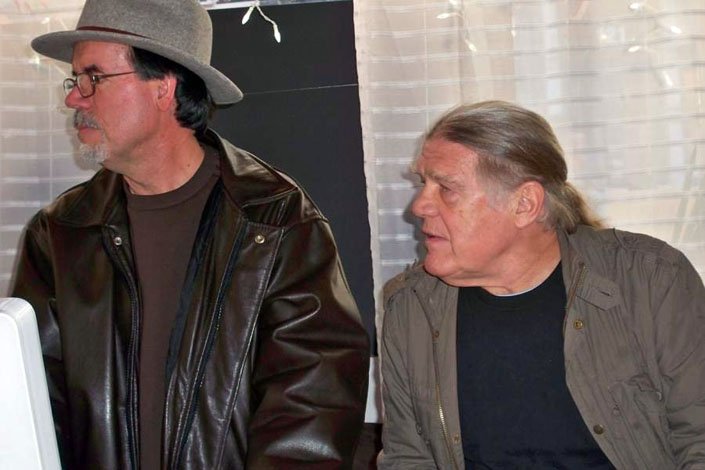
Dave Zimmer and Henry Diltz at Crosby, Stills & Nash: The Biography book signing at the Morrison Hotel Galley of Fine Art Photography, SoHo, New York City, December 2008.
